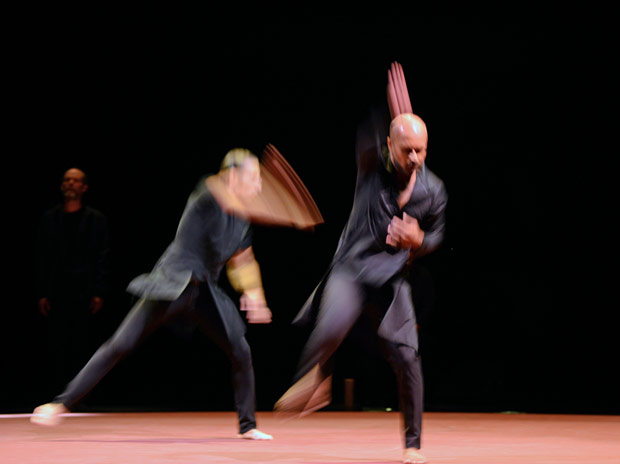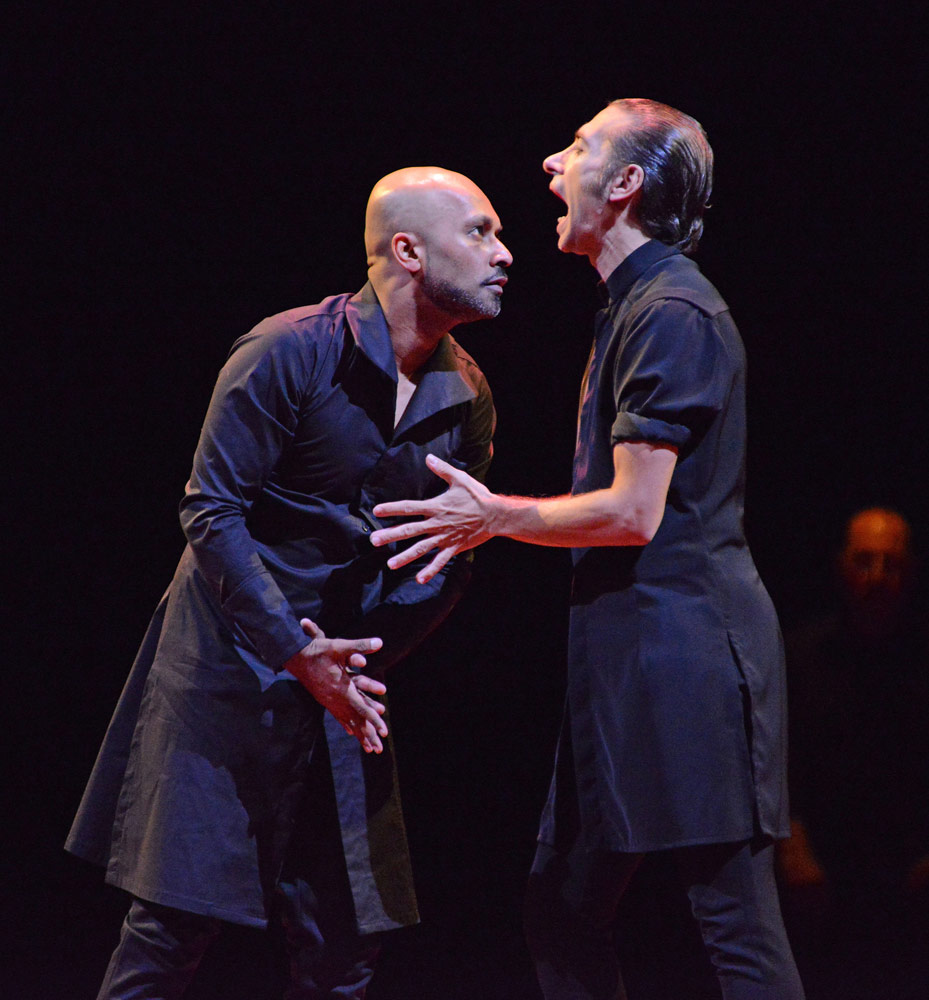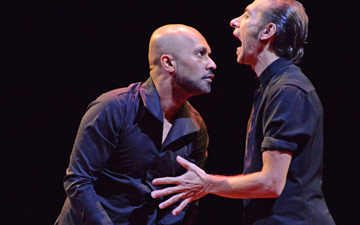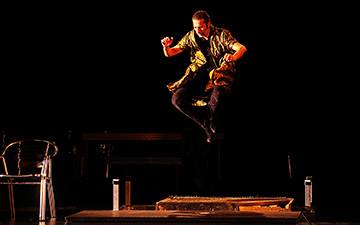
© Dave Morgan. (Click image for larger version)
Akram Khan & Israel Galván
Torobaka
London, Sadler’s Wells
30 June 2015
Gallery of pictures by Dave Morgan
www.akramkhancompany.net
In the genealogy of dance, kathak and flamenco share common ancestry. Flamenco may now be seen as the exclusive preserve of Andalusia but it arrived in Spain via Romani gypsies, migrating across Europe from the East, taking with them music and movement that had its roots in the classical dance forms of the Indian sub-continent.
The living truth of this synergy can be seen in the common core of percussive rhythm that runs through both forms; and in artistic genres that are so much more than dance. As the tabla, sitar and spoken text (the rhythmic words known as bols) are to kathak, so the handclapping (palmas), guitar and song (cante) are to flamenco. These similarities in the relationship between the two cultures – and the meeting points between them – are the platform upon which Torobaka has been created.
Each is represented by a champion. Two lions of the dance world collide and do battle before accepting a coalition of their forces; a merger of talent that is as harmonious as the tempestuous nature of their artistry will allow. Lyndsey Winship’s programme note quotes Akram Khan remembering Israel Galván’s greeting at their first meeting; when he is alleged to have said, ‘on stage, if anyone threatens me I’m going to kill them. There should be nobody on stage but me.’ There are moments, early on in Torobaka that this fearsome combativeness is bought into sharp focus; as the two men adopt fighting poses and threaten each other menacingly.

© Dave Morgan. (Click image for larger version)
They perform in a circle; a ring that has many pugnacious references from the pugilistic (though a boxing “ring” is invariably square), through sumo and into martial arts, but perhaps most contextually relevant in its allusion to the bullring. The front part of the title – Toro – is a direct reference to the bull, which Galván and Khan simulate through the use of their arms as horns in one of their several duels.
This is a comparatively quick return to Sadler’s Wells for a show that had its UK premiere on this stage, last November (having premiered in Grenoble in June 2014). It shows signs of change, not least in a tightened overall structure with clearer transitions between the sections. Some of the parts still seem over-long, there remains a slightly saggy middle and the whole design ethos is devoid of colour but the sum of the whole has a memorable impact; and like all good shows it strikes the consciousness more vividly as it accelerates towards the end. Once Khan dons the ghungroo bells about his ankles this heavyweight contest between two of the most outstanding and charismatic dancers of the current generation suddenly bursts into a work of non-stop vitality
Although the interaction between these two giants of dance is mesmerising, their individual artistry can only be truly appreciated when viewed in isolation and their diverse solos were unfailingly absorbing; notably Galván’s long opening, angry dance and Khan’s shimmering closing sequence, which is enlivened aurally by the ghungroo bells and visually by the fluidity of Michael Hulls’ lighting.
As in any contest, both camps have their supporting teams, credited as musicians but doing much more besides. Khan’s “second” is the multi-talented B C Manjunath, a percussionist who specialises in the mridanga drum; while Galván is supported by the grey-bearded, pony-tailed “El Bobote”, a master of flamenco rhythm (compás) largely delivered through hand-clapping who has worked with many great flamenco dancers (from Antonio Canales to Rocío Molina). Bobote can dance, too; suddenly exploding into a cascade of flamenco footwork to complement his palmeros.

© Dave Morgan. (Click image for larger version)
Neutrality is provided through the deep, strong voice of Christine Leboutte (a regular vocal collaborator with Sidi Larbi Cherkaoui) who brings an aesthetic to the stage that is neither overtly flamenco, nor kathak; and she is complemented by the counter-tenor, David Azurza. Despite all the competitive allusions to a duel, there’s ultimately a ying-and-yang thing going on here since everyone on stage is one half of a whole: Khan and Galván; Manjunath and Bobote; Leboutte and Azurza. They bring very different aesthetics to the same basic functions, igniting fireworks of artistic brilliance at the interface of their considerable talents.
While Khan is continuing an ongoing journey of crossing artistic borders, building upon his partnerships with, for example, Juliette Binoche, Sylvie Guillem and Cherkaoui, Galván is the son of Sevillian flamenco dancers, Jose Galván and Eugenia de Los Reyes (his sister, Pastora, is also a well-known dancer), and has always been immersed within the rarefied world of his particular art; although famed for seeking new ways of representing flamenco.
In Torobaka neither man seeks to learn – or mimic – the other’s art but there is something in the interaction of both “teams” – musically and in dance – that influences and enhances their unique skills. Between kathak and flamenco – one might say, in the middle – something is elevated.

















You must be logged in to post a comment.